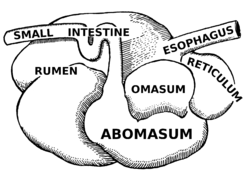
The omasum, also known as the green, [1] the fardel, [1] the manyplies [1] and the psalterium, [1] is the third compartment of the stomach in ruminants. The omasum comes after the rumen and reticulum and before the abomasum. Different ruminants have different omasum structures and function based on the food that they eat and how they developed through evolution. [2]


